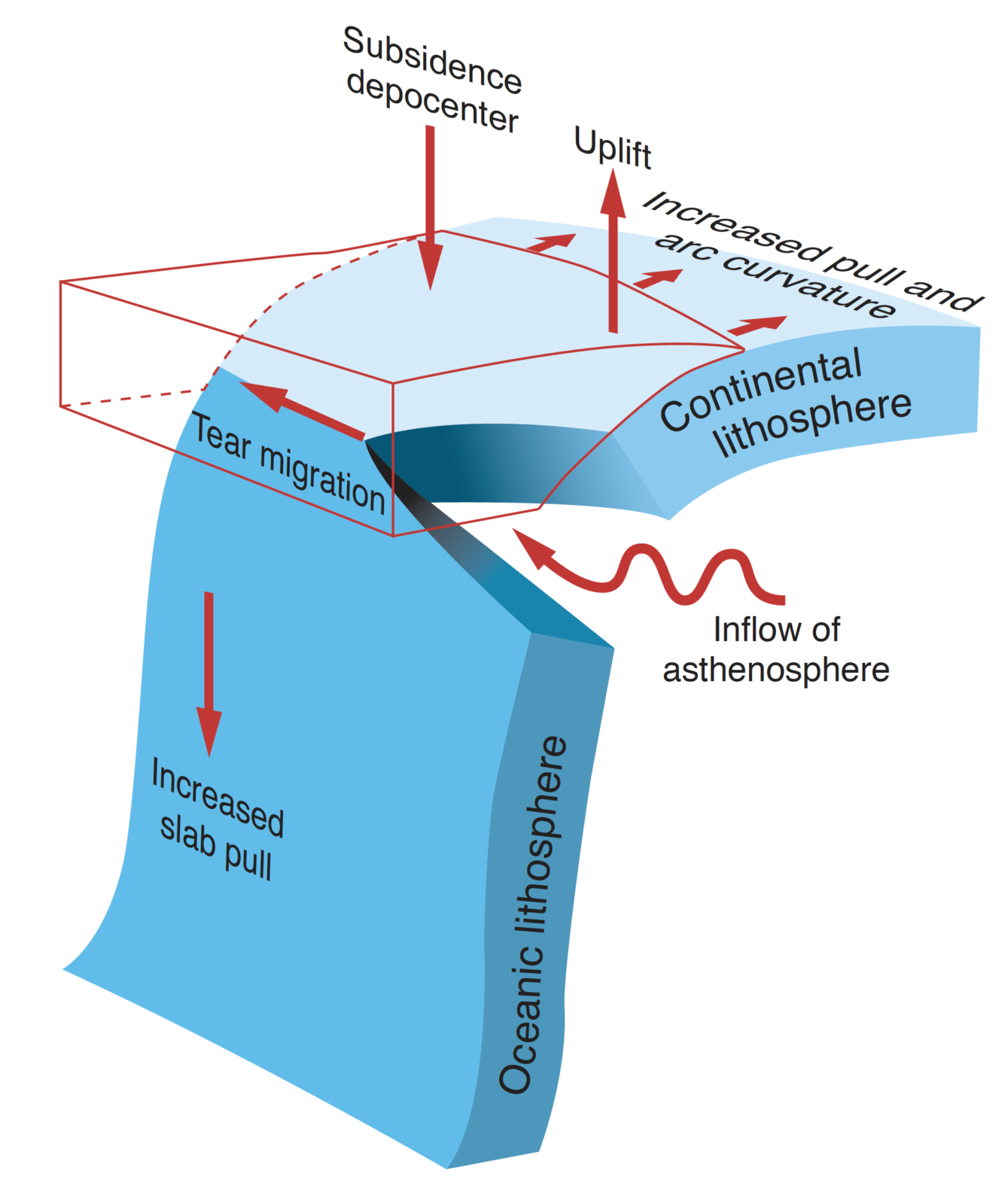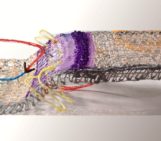
The must read paper Wortel & Spakman (2000) uses seismic tomography models showing the three-dimensional upper mantle velocity structure of the Mediterranean-Carpathian region to hypothesize lithospheric processes related to slab detachment, and particularly, the lateral migration of the detachment along plate boundaries (Fig. 1). The paper defends that this process is a key control in the lithospheric dynamics of the region during the last 20 to 30 million years, in so that it affects arc and trench migration, along-strike variations in vertical motions, stress field and magmatism. Since subduction, roll-back and, finally, slab detachment, ultimately result from the gradient in potential energy between the oceanic lithosphere and its surrounding continental lithosphere and upper mantle, Wortel and Spakman (2000) emphasize that the subduction of oceanic lithosphere should intrinsically lead to slab detachment during their mature stages of gravitational sinking.
The core of the paper starts with a description of the seismic velocity structure of the Mediterranean, as characterized by Bijwaard & Spakman (2000). During this description the authors emphasize how seismic tomography models can be used to trace subducted lithosphere. In a nutshell, if tomographic images show slabs connected to the superficial lithosphere, the amount of subducted lithosphere, and with that the subduction period, can be retrieved better than with seismicity alone. Moreover, slab detachment can be inferred where the slabs imaged are disconnected from the surficial lithosphere.

Fig 1. Plate boundary processes predicted to accompany lateral migration of slab detachments, as shown in Fig. 4 in Wortel and Spakman (2000)
After acknowledging that the seismic velocity structure derived from the models are snap-shots of the current deep structure of the Earth, the authors briefly showcase how it can be used to test the kinematic evolution portrayed by tectonic reconstructions and to derive geodynamic processes by means of hypothesis, and specifically that of the lateral migration of slab detachments. In this regards, the authors tested (i) the mechanical properties of the process, and specifically the stress distribution, change in subduction dynamics and magmatism resulting from a small tear during slab subduction, and (ii) the coherence between model predictions and independent observables, in regions where the process may have occurred, i.e., the Apennines-Calabria arc, the Carpathian arc, and the Hellenic arc.
Finally, authors provide an overview of the dynamic evolution of the Mediterranean-Carpathian region, which is known to be a particularly complex geodynamic area with multiple subduction zones. This geodynamic overview is centered around the convergence of Africa and Eurasia and its consequences, the delamination of its lithospheric mantle and derived mechanisms, and the roll-back and detachment of slabs in a land-lock setting. This helps authors remark that slab detachment is the natural last stage in terminal stage subduction zones, involving continental collision and suturing, where the subducted lithosphere is gravitationally settled.
The value and coherence of the model proposed by Wortel & Spakman (2000) must read paper was immediately obvious to the tectonic community, and the paper was originally accepted and welcomed by most. The paper sprung a wealth of scientific contributions showcasing how subduction processes have controlled the evolution of the Mediterranean and its arcs for tens of millions of years. Although this consensus is still valid currently, the continuation to date of these subduction geodynamics is starting to be put into question, the hypothesis put forward by Wortel & Spakman (2000) is deeply influenced by the snapshot (static) view of the upper mantle provided by tomographic images. A growing body of observational evidence, which includes seismic images and local bathymetric mapping, imply changes in the stress, kinematic and deformation fields throughout the Mediterranean Realm over the last ~5 Ma (Armijo et al., 1992; Schattner 2010; Gómez de la Peña et al., 2020; Zitellini et al., 2020). These observations support that the recent tectonic architecture of the Mediterranean Realm may be influenced, at present, by geodynamic processes other than those defended by this must-read paper, which remain as paradigmatic for the Mediterranean region.
Written by David Fernández-Blanco, Silvia Crosetto, Adriana Guatame-García, and the TS Must-Read Team
References
Armijo, R., Lyon-Caen, H., Papanastassiou, D., 1992. East-west extension and Holocene normal-fault scarps in the Hellenic arc. Geology 20, 491–494. https://doi.org/10.1130/0091-7613(1992)020<0491:EWEAHN>2.3.CO;2
Bijwaard, H., Spakman, W., 2000. Non-linear global P-wave tomography by iterated linearized inversion. Geophys. J. Int. 141, 71–82. https://doi.org/10.1046/j.1365-246X.2000.00053.x
Gómez de la Peña, L., R. Ranero, C., Gràcia, E., Booth-Rea, G., 2021. The evolution of the westernmost Mediterranean basins. Earth-Sci. Rev. 214, 103445. https://doi.org/10.1016/j.earscirev.2020.103445
Schattner, U., 2010. What triggered the early-to-mid Pleistocene tectonic transition across the entire eastern Mediterranean? Earth Planet. Sci. Lett. 289, 539–548. https://doi.org/10.1016/j.epsl.2009.11.048
Zitellini, N., Ranero, C.R., Filomena Loreto, M., Ligi, M., Pastore, M., D’Oriano, F., Sallares, V., Grevemeyer, I., Moeller, S., Prada, M., 2020. Recent inversion of the Tyrrhenian Basin. Geology 48, 123–127. https://doi.org/10.1130/G46774.1



